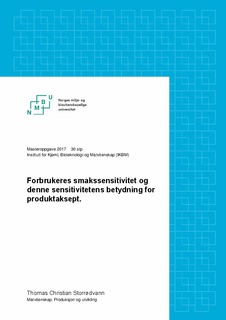| dc.contributor.advisor | Hersleth, Margrethe | |
| dc.contributor.advisor | Myhrer, Kristine Svartbekk | |
| dc.contributor.advisor | Almli, Valerie | |
| dc.contributor.author | Storrødvann, Thomas Christian | |
| dc.date.accessioned | 2017-05-24T10:48:25Z | |
| dc.date.available | 2017-05-24T10:48:25Z | |
| dc.date.issued | 2017 | |
| dc.identifier.uri | http://hdl.handle.net/11250/2443436 | |
| dc.description.abstract | Hva vi spiser har betydning for helse og livskvalitet. Det har i senere år blitt et stadig større fokus på å øke bevissthet om sunn mat, og næringsmiddelindustrien streber etter å lage sunne alternativer som forbrukerne ønsker å spise. Det er mange fysiologiske, sosiale og kulturelle faktorer bak våre produktvalg. I denne oppgaven diskuteres smakssensitivitet. Målet med oppgaven er å kartlegge variasjonen i forbrukeres smakssensitivitet og observere denne sensitivitetens betydning for aksept av utvalgte matvarer. «Suprathreshold» sensitivitet til grunnsmakene ble brukt som mål på forbrukernes sensitivitet, og målt med skalaen «generalized Labelled Magnitude Scale» (gLMS). Resultatene fra gLMS skal gi absolutt styrke og ta hensyn til fysiologiske forskjeller mellom forbrukerne. Dette gjør at resultatene kan gi gyldige sammenligninger på tvers av grupper.
Forbrukernes sensitivitet ble kartlagt ved rapportering av opplevd intensitet av grunnsmakene i grunnsmaksløsninger og i egenutviklede produkter med signifikante forskjeller i intensitetsnivåer for søt og bitter smak. Forbrukerne rapporterte også aksept for de egenutviklede produktene.
Data ble samlet gjennom to forsøk. I pilot I deltok 29 forbrukere mellom 25 og 60 år. I hovedforsøket ble det testet 40 forbrukere mellom 20 og 30 år.
Resultatene viste en mulig positiv sammenheng mellom sensitivitet for bitter grunnsmak i løsning og for produktet som var en drikk. Det ble ikke observert noen sammenheng mellom sensitivitet for søt grunnsmak i løsning og søt grunnsmak i det mer komplekse produktet, havregrøt.
Det ble også observert en mulig sammenheng mellom sensitivitet for grunnsmakene og aksept for både bitter og søt smak. For bitter smak viste den mulige sammenhengen en negativ tendens og for søt smak hadde den mulige sammenhengen en positiv tendens ved lavere sukrosenivåer og en svakt negativ tendens ved høyt sukrosenivå. gLMS skalaen fungerte bra. I begge forsøkene viste forbrukerne at de brukte den som en ratioskala med kontinuerlig akse. I pilot I skilte den også for smakerstatus. I hovedforsøket viste resultatene mulige utfordringer ved bruk av skalaen i forbindelse med lokaler og instruks. | nb_NO |
| dc.description.abstract | Food has a significant impact on health and and quality of life. In recent years it has been an increasing focus on healthy food, and the food industry aim at developing healthy, alternative, food products that consumers want to eat. Food choice are influenced by several physiological, social and cultural factors. In this thesis we will discuss taste sensitivity. The goal was to observe the variation in consumers sensitivity to basic tastes and how sensitivity is influencing consumers acceptance of selected foods. To describe the consumers taste sensitivity, it was decided to use their suprathreshold sensitivity for the basic tastes. To report response it was decided to try the «generalized Labelled Magnitude Scale» (gLMS). The gLMS is supposed to provide intensity data with absolute strength and it is supposed to take into account the physiological differences between consumers. This allows the results of the gLMS to provide valid comparisons across groups.
Consumer suprathreshold sensitivity was assessed using basic tastes solutions and products with significant different levels for sweet and bitter tastes. The consumers also reported acceptance for the products.
Data were collected through two trials. 1. In pilot I, 29 consumers associated with Nofima or NMBU were tested. The consumers were between 25 and 60 years. In the main study, 40 consumers between 20 and 30 years were tested.
The results suggested a possible tendency for a correlation between sensitivity to bitter taste in the bitter solution and in the bitter product, limonade, that is a drink. There was no correlation between sensitivity to sweet taste in the sweet solution and sensitivity to sweet taste in the sweet product, oatmeal that is a more complex product..
The results suggested a possible correlation between sensitivity to bitter taste and accept for limonade and sensitivity for sweet taste and oatmeal. For bitter taste it was suggested a negative correlation, and for sweet taste it was suggested a positive at lower sucrose levels and a neutral or slightly negative possible correlation at high sucrose levels.
The gLMS was considered satisfactory. In both pilot I and the main study the consumers managed to use it as a ratio scale with a continuous axis, and in pilot I it was satisfactory in separating the consumers by taster status. Other results from the main study highlighted potential challenges related to the use of gLMS considering context and instruction. | nb_NO |
| dc.language.iso | nob | nb_NO |
| dc.publisher | Norwegian University of Life Sciences, Ås | nb_NO |
| dc.rights | Attribution-NonCommercial-NoDerivatives 4.0 Internasjonal | * |
| dc.rights.uri | http://creativecommons.org/licenses/by-nc-nd/4.0/deed.no | * |
| dc.subject | Matvitenskap | nb_NO |
| dc.subject | Sensorikk | nb_NO |
| dc.title | Forbrukeres smakssensitivitet og denne sensitivitetens betydning for produktaksept | nb_NO |
| dc.type | Master thesis | nb_NO |
| dc.subject.nsi | VDP::Teknologi: 500::Næringsmiddelteknologi: 600 | nb_NO |
| dc.source.pagenumber | 92 | nb_NO |
| dc.description.localcode | M-MAT | nb_NO |

